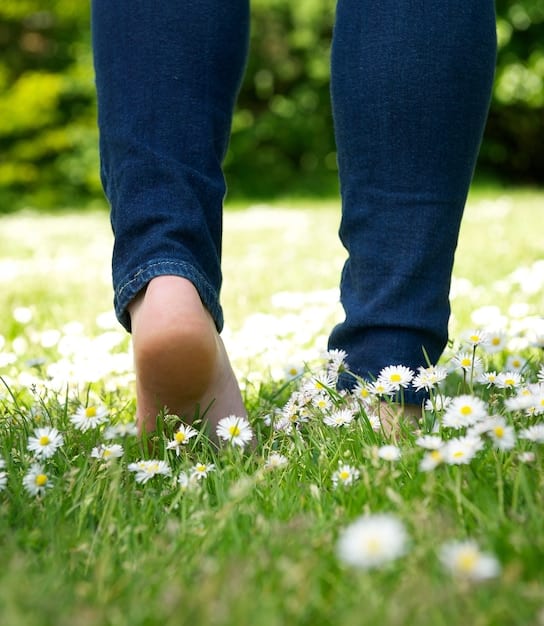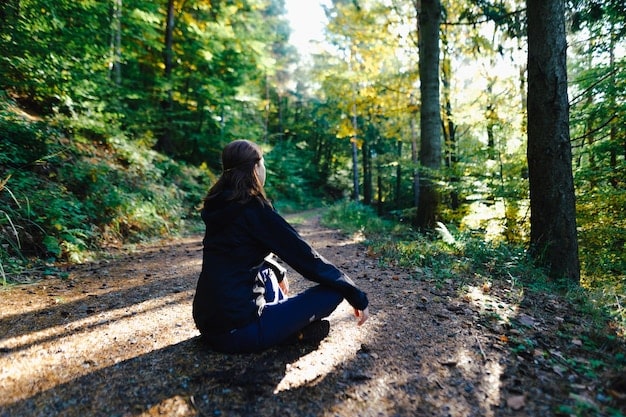Grounding Practices: Exploring Nature and Spirituality Connection

Exploring the Connection Between Nature and Spirituality: A Guide to Grounding Practices reveals how immersing oneself in the natural world can significantly enhance spiritual well-being, providing practical grounding techniques to foster inner peace and a deeper sense of connection.
Exploring the Connection Between Nature and Spirituality: A Guide to Grounding Practices unveils the profound ways in which nature can nurture our spiritual selves, offering simple yet powerful techniques to anchor us in the present moment and cultivate a sense of interconnectedness. Discover how the natural world can become your sanctuary and a pathway to inner peace.
Understanding the Intertwined Nature of Spirituality and Nature
The connection between spirituality and nature is age-old, with many traditions recognizing the natural world as a source of wisdom, healing, and profound spiritual insight. Understanding this relationship can open doors to deeper self-awareness and a more meaningful existence.
Nature often reflects the cyclical patterns of life, death, and rebirth, mirroring the spiritual journey within ourselves. By observing nature, we can gain a greater understanding of the rhythms of existence and our place within them.
The Spiritual Significance of Natural Elements
Each element of nature—earth, water, fire, and air—holds particular spiritual significance. Earth grounds us, water cleanses us, fire transforms us, and air inspires us. Engaging with these elements can enhance our spiritual experiences.
- Meditation by Water: Sitting by a river or ocean can bring emotional clarity and a sense of flow.
- Fire Gazing: Watching a campfire can spark introspection and a feeling of transformation.
- Earth Connection: Walking barefoot on the earth can ground and center you.
Connecting with nature fosters mindfulness, promoting a deeper awareness of the present moment, which is essential for spiritual growth. When we immerse ourselves in nature, we disconnect from the distractions of modern life and tune into the subtle energies around us.

Nature provides a sanctuary for contemplation and self-reflection. In quiet natural settings, we can find space to ponder life’s big questions and gain clarity on our life’s purpose and spiritual path.
Integrating nature into your spirituality involves conscious practices like mindful walking, nature journaling, and environmental stewardship. These activities deepen your connection with the natural world and cultivate spiritual well-being.
In essence, exploring the intertwined nature of spirituality and nature allows us to discover a deeper sense of belonging, purpose, and inner peace. It’s a journey of returning to our roots and recognizing the sacredness inherent in all life.
Benefits of Grounding Practices in Nature for Spiritual Growth
Grounding practices in nature offer a wealth of benefits for spiritual growth, allowing us to anchor ourselves in the present moment and connect more deeply with our inner selves. These practices help us release stress, cultivate mindfulness, and foster a sense of interconnectedness.
One of the primary benefits of grounding is stress reduction. Spending time in nature has been shown to lower cortisol levels, reducing feelings of anxiety and tension. This creates a more receptive state for spiritual exploration.
Enhancing Mindfulness Through Nature
Nature naturally promotes mindfulness, encouraging us to pay attention to the sights, sounds, and sensations around us. This heightened awareness can extend into our spiritual practices, deepening our meditative and contemplative experiences.
- Mindful Walking: Paying attention to each step and the feeling of the ground beneath your feet.
- Sensory Awareness: Noticing the smells, sounds, and textures of your natural surroundings.
- Nature Meditation: Focusing on a natural object, like a tree or flower, to anchor your attention.
Grounding also enhances our sense of interconnectedness. By acknowledging our connection to the natural world, we recognize ourselves as part of a larger whole, fostering empathy, compassion, and a sense of belonging. When we feel connected, we’re more open to spiritual insights and a feeling of unity.
Regular grounding practices can lead to increased energy and vitality. Being in nature stimulates our senses and recharges our energy reserves, leaving us feeling refreshed and revitalized. This vitality can support our spiritual practices, enabling us to approach them with greater enthusiasm and focus.
Grounding also cultivates emotional stability. Nature’s calming influence helps regulate mood and stabilize emotions, providing a solid foundation for spiritual growth. When our emotions are balanced, we can explore deeper spiritual truths with greater clarity and equanimity.
Integrating grounding practices into your spiritual routine involves making conscious choices to spend time in nature, engaging your senses, and fostering a sense of reverence for the natural world. This enhances your overall well-being and supports a more profound spiritual journey.
Simple Grounding Techniques to Connect with Nature
Connecting with nature through grounding practices is a simple yet powerful way to enhance your spiritual life. These techniques require no special equipment and can be incorporated into your daily routine, wherever you are.
One of the most accessible grounding techniques is walking barefoot on the earth. This practice allows you to directly connect with the Earth’s energy, promoting balance and stability. Aim for at least a few minutes each day to experience the benefits.
Practical Grounding Exercises
To further enhance your connection with nature, there are several exercises you can incorporate into your routine. From tree-hugging to earthing mats, you can try a variety of methods to physically connect with nature.
- Tree Hugging: Wrapping your arms around a tree to feel its energy and presence.
- Earthing Mats: Using special mats to connect with the Earth’s electrons while indoors.
- Nature Walks: Taking leisurely walks in natural settings, focusing on your breath and surroundings.
Another effective technique is nature meditation. Find a quiet spot in nature, close your eyes, and focus on your breath. Pay attention to the sounds around you, the feeling of the air on your skin, and the sensations in your body. This practice cultivates mindfulness and presence, enhancing your connection with nature.

Gardening is another grounding activity that allows you to connect with the earth and nurture life. The act of planting, watering, and tending to plants can be deeply meditative and rewarding, fostering a sense of connection and purpose.
Spending time by water, whether it’s a river, lake, or ocean, is also a powerful grounding practice. Water has a natural calming effect, helping to soothe emotions and promote relaxation. Sit by the water, listen to its sounds, and feel its energy washing over you.
By incorporating these simple grounding techniques into your daily life, you can strengthen your connection with nature and enhance your spiritual well-being. Small, consistent practices can make a and profound difference in your overall sense of peace and connectedness.
Creating a Nature-Based Spiritual Practice
Establishing a spiritual practice rooted in nature can deepen your understanding of yourself and the world around you. This involves intentionally incorporating natural elements and activities into your spiritual routine, creating a personalized and meaningful experience.
Begin by identifying the natural elements that resonate with you most, whether it’s trees, water, mountains, or flowers. Reflect on what these elements symbolize for you and how they make you feel. Use this connection to guide the design of your practice.
Integrating Nature into Your Routine
Integrating nature into your daily routine can open your eyes to many new methods of worship and meditation. From indoor plants to outdoor activities, here are a few to get you started.
- Indoor Plants: Curating indoor plants to liven up your home and enhance your mood.
- Natural Altars: Creating an altar with natural items like plants and rocks.
- Outdoor Adventures: Hiking, kayaking, and other activities to get close to nature.
Consider creating a dedicated space in your home or garden where you can connect with nature. This could be a meditation corner with plants and stones, a small garden where you grow herbs or flowers, or even a balcony where you can sit and observe the sky.
Incorporate nature into your meditation practice. Take your meditation outdoors, if possible, and focus on the natural sounds and sensations around you. If you’re meditating indoors, use natural objects like crystals or essential oils to enhance the experience.
Nature journaling is another powerful way to deepen your connection with the natural world. Take time to write about your experiences in nature, recording your observations, reflections, and insights. This practice helps you become more aware of the details around you and cultivates a sense of gratitude and wonder.
Remember to approach your nature-based spiritual practice with respect and reverence for the natural world. This means being mindful of your impact on the environment and choosing practices that are sustainable and ethical. By honoring nature, you deepen your spiritual connection and contribute to the well-being of the planet.
By consciously integrating nature into your spiritual journey, you create a pathway to greater peace, connection, and understanding. This practice nurtures your spirit, enhances your awareness, and fosters a deep sense of belonging to the natural world.
The Role of Nature in Traditional Spiritual Practices
Throughout history, the natural world has played a central role in various spiritual traditions. From ancient indigenous cultures to modern-day practices, nature serves as a source of sacred wisdom, ritual, and connection to the divine.
Many indigenous cultures view nature as sacred, recognizing that all living things possess a spirit and are interconnected. These traditions often incorporate natural elements like plants, animals, and landscapes into their ceremonies and rituals, honoring the Earth as a living, breathing entity.
Nature Throughout Many Cultures
All throughout the world, there are many ways nature is included in culture, worship, and spirtuality. From Chinese tradition to modern-day Wicca, learn about ways to immerse yourself in nature today.
- Chinese Tradition: Incorporating natural elements into feng shui to create harmonious living spaces.
- Wicca: Drawing upon the power of the elements and celebrating seasonal festivals.
- Hinduism: Acknowledging the presence of the divine in rivers, mountains, and sacred groves.
In many spiritual traditions, nature symbolizes the cycles of life, death, and rebirth, reminding us of the transitory nature of existence. By observing nature, we can gain a deeper understanding of these cycles and our place within them.
Nature also serves as a mirror, reflecting our inner selves. By spending time in nature, we can gain insights into our own emotions, thoughts, and patterns. The calmness and beauty of nature provide a space for introspection and self-reflection.
Today, many people are returning to nature-based spirituality as a way to reconnect with their roots and find deeper meaning in their lives. This involves incorporating practices like nature walks, gardening, and environmental activism into their spiritual routines, honoring the Earth and promoting sustainability.
Exploring the role of nature in traditional spiritual practices enables us to recognize the rich and diverse ways that humanity has connected with the natural world throughout history. It invites us to learn from these traditions and incorporate their wisdom into our own spiritual journeys, fostering a deeper sense of reverence and interconnectedness.
Overcoming Challenges in Connecting with Nature
In today’s fast-paced, technology-driven world, connecting with nature can present unique challenges. Many people live in urban environments, have busy schedules, and spend a significant amount of time indoors. Overcoming these obstacles requires intentional effort and creativity.
One of the most significant challenges is the lack of access to natural spaces. If you live in a city, consider exploring local parks, gardens, and green spaces. Even a small patch of nature can provide a sense of calm and connection.
Solutions for Better Connections
Even if you don’t have ready access to parks or wide open spaces, there are still several things you can do to connect with nature and worship and meditate at your own pace. From indoor plants to short walks, you can still connect with nature.
- Indoor Plants: Bringing the natural world indoors by caring for plants.
- Desktop Meditation: Taking short breaks to connect with nature, even in an office setting.
- Weekend Trip: Making conscious efforts to spend time in nature during your free time.
Time constraints can also be a barrier to connecting with nature. If you have a busy schedule, try to incorporate small bursts of nature into your daily routine. This could involve taking a short walk during your lunch break, meditating by a window, or pausing to appreciate a sunset. Little moments can make a big difference.
Another challenge is overcoming the feeling of discomfort or unfamiliarity with nature. If you’re not used to spending time outdoors, you may feel awkward or unsure of what to do. Start small and gradually increase your exposure to nature. Join a hiking group, take a nature photography class, or simply spend time sitting in a park.
Technology can also be a distraction from nature. Make a conscious effort to disconnect from your devices when you’re in natural settings. Turn off your phone, leave your laptop at home, and focus on engaging with the world around you.
By addressing these challenges with intentionality and creativity, you can create opportunities to connect with nature and enhance your spiritual well-being. Small steps can lead to big changes, and even brief moments of connection can have a profound impact.
| Key Point | Brief Description |
|---|---|
| 🌱 Grounding Practices | Techniques to connect with the earth for spiritual balance. |
| 🧘 Nature Meditation | Mindfulness practices in natural settings to enhance spiritual awareness. |
| 👣 Barefoot Walking | Direct contact with the earth to reduce stress and increase energy. |
| 🌿 Nature Journaling | Recording observations in nature to deepen connection and reflection. |
FAQ
▼
Grounding practices are activities that help you connect with the earth and the present moment. They can include activities like walking barefoot on the grass, gardening, or spending time in natural settings.
▼
Nature enhances spirituality through various ways by calming the mind, reduces stress, and promotes a feeling of interconnectedness. It provides a serene environment for contemplation and self-reflection, fostering a deeper spiritual connection.
▼
Yes, you can practice grounding indoors by using earthing mats, caring for indoor plants, or meditating by a window with a view of nature. Visualizations of natural landscapes can also be effective.
▼
Even in urban environments, seek out local parks, gardens, and green spaces to spend time in nature. Gardening on a balcony, using nature sounds for meditation, and taking short walks can also provide grounding benefits.
▼
Ideally, you should practice grounding daily, even if it’s just for a few minutes. Consistent exposure to nature enhances your spiritual connection and overall well-being. Find what works best for your routine and make it a habit.
Conclusion
In conclusion, exploring the Connection Between Nature and Spirituality: A Guide to Grounding Practices offers a transformative pathway to enhance your spiritual journey, inviting you to incorporate simple yet profound practices into everyday life, transforming stress into serenity and disconnection into deep connection.





